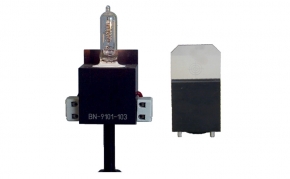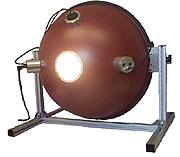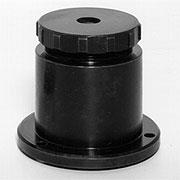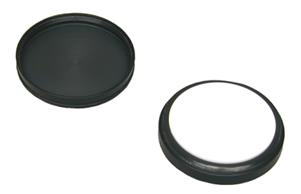4.4 Calibration Standards
Calibration standards are employed to generate an input quantity for the equipment used in the calibration. Since the calibration standard supplies a signal of known quantity, the difference of the output signal of the equipment to the signal of the calibration standard can be evaluated. These differences can then be used to calculate calibration correction factors and hence allowing for absolute readings when the output signal is corrected using these values. Different calibration standards are needed for photometric and radiometric measurement quantities:
| Photometric quantity | Radiometric quantity |
| Luminous flux | Radiant power |
| Luminous intensity | Radiant Intensity |
| Luminance | Radiance |
| Illuminance | Irradiance |
Tab 1: Photometric and radiometric quantities
Equivalent photometric and radiometric quantities exist if the measurements and hence the calibration geometries are the same. The only difference is the radiometric or photometric responsivity of the detection system. This means most calibration reference standards can be used for both photometric and radiometric calibration if the calibration data is available. For very precise or close tolerance calibrations, specially selected calibration standards are needed. Typically, calibration standards are used as transfer standards, meaning they transfer the values of the primary standard to a laboratory standard for subsequent transfer to a device under test. For traceable calibrations, an unbroken chain of transfer comparisons, which can be traced back to the national primary standard, is certified. Calibration uncertainty is of course dependent on the calibration hierarchy of the standard. Since the calibration transfer is a real hardware transfer of the standard itself, careful handling and operation of the calibration standard is extremely important. In imaging applications, the uniformity of response or transmittance is critical. Light sources with a uniform luminous area are therefore needed to determine the non-uniformity of a lens system or visual imaging detection system.
The following sections give information on:
Source Based Standards
Every optical radiation detection or measurement system needs to be calibrated in reference to an optical radiation source. There are two possible ways to perform the calibration:
- The source can be calibrated in the required quantity and the difference between the input signal generated by the source and the output signal of the detection system can be determined using the calibration data of the source
- The uncalibrated source can be operated under stable conditions and the calibration done by comparing the reading of the detection system with a calibrated detection system (reference standard). The reference standard must have the same measurement geometry and spectral response as the unit to be calibrated.
The most common optical radiation source used for calibration standards is the tungsten halogen lamp since its emission spectrum is close to a Planckian radiator (blackbody source). Other sources where optical radiation is produced by means of an element heated to incandescence by electrical current are also used. Both the position of the filament and the stability of the tungsten halogen lamp, which has a limited lifetime, are critical. Therefore, the lamp should only be operated in the position specified in the calibration certificate. Comparing the lamp output with other in-house reference standard sources or suitable reference detection systems must be done periodically in order to verify the stated lamp calibration uncertainty. In radiometric applications where the spectral characteristic of the source is used, the source should be operated in current controlled mode so as to ensure stability of the spectral characteristics. The minimum specification for current stability should be held at 10 A – 4 A. In photometric applications or radiometric applications with broadband detectors, intensity controllable standards can be used if changes in the spectral emission characteristics are not critical. If the tungsten halogen lamp is used as a spot source, the exact location on the filament used dur ing the calibration of the source must also be used subsequently. In luminance, radiance and imaging uniformity calibrations, tungsten halogen lamps must be fitted with a diffuse screen or placed within an integrat ing sphere. Sphere based luminance and radiance standards offer higher uniformity and a better diffuse function.

Fig. 1: Diffuse screen and integrating sphere
A diffuse transmitting screen can be used at the sphere output in the calibration of luminance and radiance meters with a limited field-of-view. In imaging applications, the uniformity and the diffuse function of currently available screen materials are not precise enough and thus, the open output port of the sphere is typically used. If the intensity of the tungsten halogen lamp is not high enough, which is the case especially in the UV range, arc lamps such as xenon lamps may be used. However, the increase in intensity can affect the calibration uncertainty.
Detector Based Standards
Due to the high levels of maintenance and care required to operate optical radiation source based calibration standards, detector based standards are very attractive alternatives. The detectors, particularly semiconductor detectors, have the advantage of long-term absolute and mechanical stability. The use of detector-based standards is very common in monochromatic radiometric applications such as the calibration of laser power meters for telecommunication testing. However, the use of detector based calibration standards must be carefully considered because of surface reflections, polarization effects, beam misalignment and beam ‘bounce-back’ errors. The use of spectrally broadband detectors as calibration standards is mostly limited to photometric applications where detectors with a precise filter corrected photometric spectral response are available. Calibration is performed by comparing the output signal of the reference detector to that of the device to be calibrated. The same stable source of optical radiation is used during the calibration procedure. For monochromatic calibrations, a monochromatic radiation source is needed. If a detector‘s spectral responsivity is to be measured over its entire active bandpass, a tungsten halogen lamp with a monochromator attached to it can be used to create monochromatic radiation at all of the different required wavelengths.
Spectral Irradiance Standards
Tungsten Halogen lamps are the “workhorse” of spectral irradiance standards. FEL type lamps with a filament support arm are recommended for high intensity BLUE light and UV applications.

Fig. 2: FEL calibration standard lamp
Sylvania calibration grade lamps are recommended for visible and near IR applications where the best long term stability is required. In order to qualify for calibration as a standard, each lamp must undergo at least a 15-hour burnin procedure and must display a satisfactory burnin data trend during this period. The calibrated tungsten reference source provides spectral irradiance data from 250 nm to 2500 nm covering many typical UV-Vis-IR radiometric and photometric applications. The lamp is normally provided in a housing and socket made of ceramic or other material that ensures long-term stability and protection. Filament targeting aids may be provided for best measurement accuracy in the calibration laboratory. Since the lifetime is somewhat limited, lamp power supplies with on/off ramping functions are recommended for use with these sources.

Fig. 3: Lamp spectral distribution
Luminance Standards
Luminance reference sources are used to calibrate the uniformity of imaging systems and luminance output of luminance meters, spot exposure meters and other photometric equipment.

Fig. 4: Luminance standard
The standard is constructed around the integrating sphere of various diameters designed to provide the highly uniform diffuse luminance at the exit port that is required for this type of calibrations. The spheres might be coated with barium sulfate or made using optically diffuse plastics. Seasoned tungsten halogen sources are typically used with lamp power supplies and temperature stabilized photometric reference detectors to form the complete system. Control feedback loop techniques control the luminance output intensity and help prolong the useable lifetime of the system. Any change in ambient and sphere body temperature affecting the output signal is eliminated through the temperature stabilized reference detector. This also reduces system warm-up time. An optimally designed sphere layout is capable of less than ± 0.7 % non-uniformity over 90 % of the port opening, which can be as large as 100 mm in diameter. Less than ± 5 % angular uniformity within ± 40° enables luminance output calibration of detection systems with wide acceptance angles. Luminance outputs can range from 0.5 cd/m2 to 35000 cd/m². Some standards may offer a variable luminance output requiring more sophisticated electronics, multiple lamps and exhaust fans. In order to qualify as a calibration standard, the system itself must be calibrated by a competent calibration facility. Luminance output, uniformity and angular uniformity must be measured and certified.

Fig. 5: Typical luminance uniformity response plot
Spectral Radiance Standards
Radiance reference sources are used to calibrate radiance detectors and other radiometric equipment. The standard is constructed around the integrating sphere of various diameters designed to provide the highly uniform diffuse radiance at the exit port that is required for this type of calibrations.
The spheres might be coated with barium sulfate or made using optically diffuse plastics. Seasoned tungsten halogen sources are typically used with lamp power supplies and temperature stabilized photometric reference detectors to form the complete system. Control feedback loop techniques control the luminance output intensity and help prolong the useable lifetime of the system. Any change in ambient and sphere body temperature affecting the output signal is eliminated through the temperature stabilized reference detector. This also reduces the system warm-up time.
An optimally designed sphere layout is capable of less than ± 0.7 % non-uniformity over 90 % of the port opening, which can be as large as 100 mm in diameter. Less than ± 5 % angular uniformity within ± 40° enables luminance output calibration of detection systems with wide acceptance angles. Some standards may offer a variable radiance output requiring more sophisticated electronics, multiple lamps and exhaust fans. In order to qualify as a calibration standard the system itself must be calibrated by a competent calibration facility. Radiance output, uniformity and angular uniformity must be measured and certified.

Fig. 6: Typical spectral radiance plot Plot
Spectral Responsivity Standards
Due to their long term stability and broad spectral coverage, silicon photodiodes are used as reference spectral standards by national and private calibration laboratories worldwide.

Fig. 7: Detector calibration standard
These photodiodes, which have active areas that are as large as 100 mm2, are mounted into machined housings to protect and precisely fix the detector in a calibration setup together with targeting aids. Some housings may include an integral temperature sensor to monitor thermal characteristics during test sessions. In order to ensure best measurement uncertainty, temperature stabilization using cooling jackets that maintain the device temperature to within ± 0.5 °C are also used. UV enhanced Si devices offer spectral coverage from 250 nm to > 1100 nm. Calibration with certification from an accredited traceable calibration facility is required to qualify the device for use as a reference standard.

Fig. 8: Typical spectral responsivity plot of Si PTD
Reflectance Standards
White optically diffuse reflectance standards traceably calibrated for spectral reflectance over a spectral range from 250 nm to 2500 nm are used in the calibration of reflectance meters, optical distance measurement systems, densitometers, spectrophotometers and other optical and imaging systems. Qualifications of a reflectance standard include light and temperature stability and durability near the Lambertian diffuse reflectance and up to 98 % spectrally neutral reflectance over the spectral range of interest. Processed PTFE, which is cut into various shapes and thicknesses, is currently used for reflectance standards. High reflectance white, black and gray shades at varying reflectance values are available.
In order to maintain the quality of a calibrated standard, the standard is normally mounted into a protective housing with a removable lid to keep the material clean and covered when not in use.

Fig. 9: Optically diffuse reflectance standards
Geometry Adjusted Calibration Standards
For sophisticated measurement tasks, the type of calibration lamp becomes very important. For example, when measuring the total luminous flux of LEDs within an integrating sphere, the system should be calibrated to match the radiation distribution of the LED. The “compare like with like” basic principle applies. If a measurement system is typically used to characterize LEDs that only emit light into a half-space, this should also apply for the calibration light source. For this kind of calibration, only 2π standards should be used.